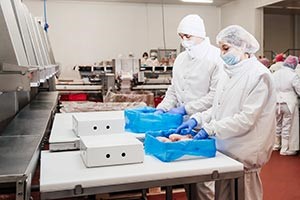Two Invisible Hazards for Food Processing Workers

When we think about potential risks in the food processing industry, some are obvious: sharp objects, machinery, falls, cross-contamination, and chemicals. But not all dangers are so recognizable. These workers are often exposed to damaging levels of noise and extreme temperatures.
Noise Hazards
Did you know that hearing loss is more prevalent in food processing than most other industries, with an average incidence rate of 43.0 cases per 10,000 workers according to the U.S. Bureau of Labor Statistics? This is the third-highest rate of occupational hearing loss. Certain segments of the industry have worse outcomes: beet sugar processing has a 66.4 rate, while frozen fruit, juice, and vegetable manufacturing facility employees have a 46.1 rate.
You might not think of food production as being that loud, but much of the equipment used is noisy: food prep machinery that slices or peels food; conveyer belts; compressed air; even pumps to process juice can have a rating of over 100 db. Auditory damage requires less volume than you’d think: The Occupational Health and Safety Administration (OSHA) considers 85 dB or above hazardous noise, which is exceeded by even something as common as a bottling line (90-95 dB). OSHA requires employers to institute a hearing conservation program when workers are exposed to noise at this level over 8 working hours.
The safeguards necessary to protect workers have been long established by OSHA and require workplaces meeting the “85 dB over 8 hours” standard to monitor noise levels and provide hearing protection to employees, with a selection of at least one variety of ear plug and one variety of ear muff. They also require employers to provide regular, no-cost hearing tests and noise awareness training for workers. Hearing loss is permanent and can impede someone’s ability to work. A hearing conservation program doesn’t just protect your employees’ hearing, but also their livelihoods.
Temperature Hazards
Extreme temperatures, both hot and cold, are another invisible hazard of food processing. These temperatures are often necessary for safe food practices and can’t be avoided. In these instances, additional safety precautions are necessary.
Why is heat stress a risk? Excessive time in poorly ventilated facilities, around radiant heat sources, or without adequate water and breaks can prevent your body from dissipating heat. Potentially dangerous illnesses like heat exhaustion, fainting, and heat stroke can result. OSHA recommends workplaces establish a heat illness prevention program that includes heat stress training, modified work schedules with frequent water breaks and rest in shaded environments, trained workers to monitor heat conditions, and acclimatization practices for new employees unused to working in hot conditions.
What about cold stress? Many food processing facilities involve work in refrigerated warehouses, freezers, and other cold environments. Working in the cold without proper clothing and warming protective gear can lead to conditions like frostbite and trench foot, which in severe cases can require amputation, and hypothermia, which is potentially fatal. Even shivering can cause inaccurate work and lost productivity. OSHA recommends workplaces train employees on cold stress awareness, train supervisors in spotting cold stress symptoms, allow adequate breaks for warming up, and provide warm clothing like insulated jackets, gloves, and hard hat liners, as well as other warming protective equipment.
When a hazard is less obvious, both employers and workers may disregard or remain oblivious to it until someone is harmed. Proper environmental monitoring can teach employers what dangers they should address before an issue occurs. By implementing administrative and engineering controls, as well as providing protective equipment, training, and adequate rest, employers can protect the health of their employees from the dangers of excessive noise and extreme temperatures.


